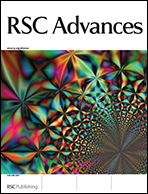One-pot two-component tandem multiple transformations in the synthesis of N,4-diaryl-2,3-dihydropyrrolo[3,4-c]quinolin-1,3-diones and their 3-thioxo-analogues under neat conditions†
Abstract
An efficient and exclusive synthesis of a decent library of hitherto unknown N,4-diaryl-3-thioxo-2,3-dihydropyrrolo[3,4-c]quinolin-1-ones by a one-pot two-component cascade reaction protocol under solvent-free conditions is disclosed for the first time. This novel procedure involves easy to obtain isatin and N,3-diaryl-3-oxo-propanthioamide derivatives in a series of DMAP catalyzed in situ transformations giving water as the only by-product. The protocol avoids the use of expensive catalysts, toxic reagents, solvents and difficult reaction conditions, and the exclusive product formed is purified without column chromatography by simply washing the crude reaction mass with ethanol to remove the unused starting materials. The generality of this cost-effective, eco-friendly and practical method is established by preparing several new 2,4-diaryl-pyrrolo[3,4-c]quinolin-1,3-diones from the corresponding ketene-N,O-acetals in excellent yield. A plausible reaction mechanism for the product formation is proposed.
![Graphical abstract: One-pot two-component tandem multiple transformations in the synthesis of N,4-diaryl-2,3-dihydropyrrolo[3,4-c]quinolin-1,3-diones and their 3-thioxo-analogues under neat conditions](/en/Image/Get?imageInfo.ImageType=GA&imageInfo.ImageIdentifier.ManuscriptID=C3RA43489C&imageInfo.ImageIdentifier.Year=2013)

 Please wait while we load your content...
Please wait while we load your content...